 |
||
|
||
| ||
The Creative Audigy2 Platinum eX sound card coming with an external unit is the most expensive and advanced model of the Audigy2 family and it's launched half a year after the Audigy2 Player and Audigy2 Platinum. The manufacturer promotes the Platinum eX as a solution for musicians and gamers underlining the studio quality of its external unit. Here's what distinguishes the Audigy2 Platinum eX from the Audigy2 Player/Platinum:
The box contents
Appearance and connectors The card doesn't differ much from the Audigy2. It's assembled on the same black textolite, has the same controller and codec. Nonetheless, there are no CD in, S/PDIF in, Aux in, TAD in connectors. A noisy AC'97 codec and ADC from Philips are also removed. The company says that these measures improve the sound quality.  The design of the external module reminds that of the Creative Extigy USB device. But the external unit of the Audigy2 PlatinumEX is more massive and comes with more connectors. One of the interesting moments is muting by pressing the volume control. There is also the CMSS activation button. Everything works synchronously with the card's software mixer.


 Remote control The remote control is identical to that of the Audigy2. Hardware features
Unexpectedly, the ADC maker was changed from Philips to Burr-Brown. But it's not enough to replace converters or improve their specs to raise the sampling quality. Creative mentions that an external unit is protected from pickups a card is exposed to inside a PC case. But the experience shows that external devices have no advantages over internal ones except the fact that it's easier to reach them. Quality entirely depends on realization. Software features
There's still no 16/44 in the ASIO. The mode of 24/96 is realized in software via a virtual ASIO device. 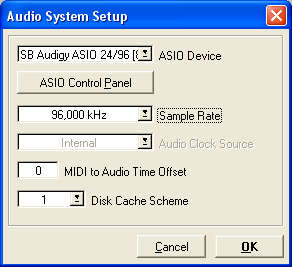 During installation of the Cubasys VST you will be warned that the ASIO should be used in the 16/48 mode. The sequencer can actually quickly convert all files from 44 to 48 kHz, and the EMU Sample Rate Convertor comes bundled with the card. But such conversions do not raise quality at all.  The professional software coming with the card looks dated. It's very inconvenient to work in the old-fashioned Cubasis VST, and it doesn't realize capabilities of the ASIO2 in full. The Wavelab Lite doesn't support the ASIO at all. UtilitiesThe card management software suite didn't change since the Audigy2 Platinum (the review of which describes it well). 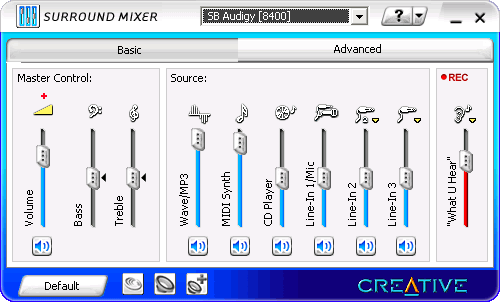 As I said above, there's only 44.1 kHz added. 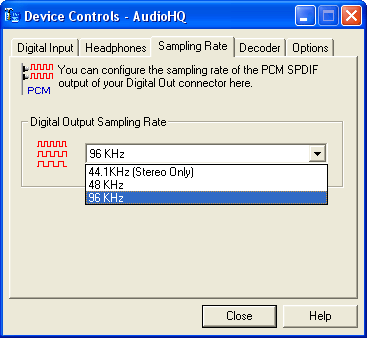 Demo programsIn this respect Creative is praiseworthy. All demo programs are new, and interactive presentations are fully remade. After installation of the software and rebooting we were offered to look through the information on purchasing and to listen to a sample in the format of 24bit 192kHz. Other card makers do not offer such pleasantries.  All card's features are described in detail in special interactive presentations.  There's even a 3D graphics demo where you can walk in a medieval castle, listen to EAX3 effects and adjust parameters. 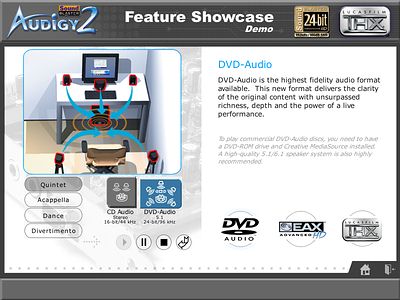 Also, you can compare 16/44 stereo and 24/96 5.1 on-the-fly switching from one format to another while a composition is playing. There's even a DVD-Audio. However, Creative's DVD-A player can't play its video part, and graphics and text records weren't shown. We could see it only on the Pioneer 757Ai DVD-A/SACD player. RMAA 5.1 testsMeasurements were taken with the Lynx Two reference card (117 dB SNR) with a short low-noise microphone cable, Proel, with gold-plated connectors. The input sensitivity of the Lynx Two is standard: -10 dB V. Front-outIn the RMAA 5.1 we changed IMD test frequencies from those recommended by the CCIF standard for SMPTE since some of multimedia cards with the frequency fixed at 48 kHz had problems of clipping the 16bit grid because of too much distortions at 44kHz. Now the test more adequately estimates distortions from intermodulation related with non-linearity of the analog section, as well as combination distortions and flaws caused by operation of the conversion algorithms in the audible range. (The test with the previous CCIF preset still makes sense for testing quality of digital filtering and oversampling of high-quality and professional devices.) Mode of operation: 16 bit 44 kHz
General performance: Very good The detailed results for the front output for 16 bits 44 kHz are here.  The frequency response diagram in the 44kHz mode makes almost a straight line  The IMD (SMPTE) spectrogram reveals parasitic components at 44kHz  The THD spectrogram indicates that there are harmonic distortions at 44 kHz Mode of operation: 16 bits 48 kHz
General performance: Excellent  The IMD (SMPTE) spectrogram shows that the 48kHz mode is not deprived of some pickups See the detailed results for the front output for 16 bits 48 kHz. Mode of operation: 24 bits 96 kHz
General performance: Excellent See the detailed results for the front output for 24 bits 96 kHz. Mode of operation: 24 bits 192 kHz
General performance: Very good See the detailed results for the front output for 24 bits 192 kHz. So, the main problem of the Audigy2 family is the lack of a mode of signal passage without forced processing. That is why the potential of the high-quality DACs is not made used of. Another interesting fact: the measurement results of the Audigy2 and Audigy2 Platinum eX installed into the same test system coincide. Line-inAs you can see, it brings no advantages to place the ADC outside a PC case. The card is of little use for professional purposes and quality recording. Mode of operation: 16 bits 44 kHz
General performance: Very good See the detailed results for the line-in for 16 bits 44 kHz. Mode of operation: 24 bits 96 kHz
General performance: Very good See the detailed results for the line-in for 24 bits 96 kHz. Digital-outThe data transfer with bit accuracy is possible only in the mode of 24 bits 96 kHz and only for data in the format of 24 bits 96 kHz when the signal passes by the DSP algorithms. That is why we recommend the software sample rate conversion (SSRC). Mode of operation: 16 bits 44 kHz
General performance: Very good  The THD spectrogram shows that the signal goes with distortions at 44kHz See the detailed results for the digital-out for 16 bits 44 kHz. Mode of operation: 16 bits 48 kHz
General performance: Excellent  The THD spectrogram demonstrates a bit better scores at 48 kHz See the detailed results for the digital-out for 16 bits 48 kHz. Mode of operation: 24 bits 96 kHz
General performance: Excellent  Fortunately, the signal is transferred bit to bit at 24 bits 96 kHz See the detailed
results for the digital-out for 24 bits 96 kHz. RightMark 3DSound TestsDirectSound diagnosticsDevice: SB Audigy Audio [8400]Features: Rates:
Free buffers stats:
Max buffers stats: CPU utilization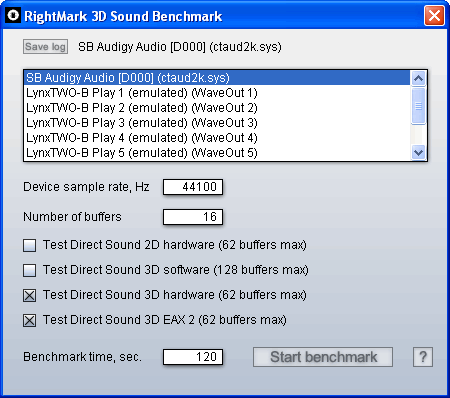 Windows XP SP1, DirectX8.1, Athlon XP 2100+, KT333, DDR333.
CPU load (%) is given for different modes of operation and for a different number of DirectSound buffers. The average value and dispersion go after the slash (mean of distribution and standard deviation) for the 2-minute test and with accidental releases of the system discounted (swap etc.). Creative now frequently updates drivers with performance optimization. We have tested the Audigy2 card with the drivers bundled with it and with the updated version AUD2DRVLB030425. Subjective testsThe Event 20/20bas active monitors were used in the comparison tests. We noticed no difference between the Audigy2 Platinum and Audigy2 Platinum eX, - the Platinum eX leaves the same impression as the Audigy2. You can read about quality of the Audigy2 and its comparison with other modern sound cards in the following reviews: Audiotrak Prodigy7.1, Terratec Aureon 7.1 Space, M-Audio Revolution 7.1. ConclusionThe Audigy2 Platinum eX an a perfect choice for a gamer, but wouldn't suite an audiophile or a professional musician. We'd recommend to have a separate card for such purposes and leave the Audigy2 for game applications. Highs
Lows
Write a comment below. No registration needed!
|
Platform · Video · Multimedia · Mobile · Other || About us & Privacy policy · Twitter · Facebook Copyright © Byrds Research & Publishing, Ltd., 1997–2011. All rights reserved. |